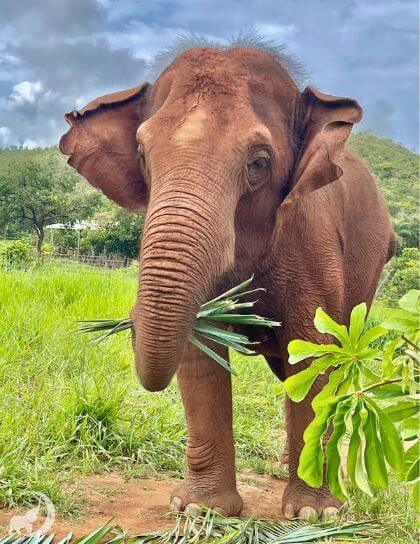What will it be like for a whale arriving at the sanctuary after a lifetime spent in a small concrete tank?
For a helpful parallel, we asked Scott Blais, the founder of Elephant Sanctuary Brazil, what it was like for Guillermina, an elephant who had been born in a concrete pit at a zoo and had lived there for 24 years – all alone most of that time – before being rescued and brought to their sanctuary.

Elephants are the largest of all land animals. And in the wild, a family of elephants walks tens of miles every day. (In the ocean, a pod of whales can travel a hundred miles a day.) Built to walk many miles, but with nowhere to go, Guillermina had simply paced around her cell in small circles. Round and round; over and over.
You might think, then, that she’d be thrilled to run into the fields and forests of an elephant sanctuary. But at first, Scott told us, Guillermina didn’t want to go anywhere. She just wanted to walk in small circles, just like she’d done for years in the concrete pit at the zoo where she’d been born 24 years earlier.
Scott wasn’t surprised by Guillermina’s behavior. After all, she’d never even witnessed the sun rising or setting on the horizon. She knew nothing of the expanse of the world beyond. Her whole universe was that concrete pit.
How had she survived psychologically in a world for which nature had not equipped her? In the face of solitary confinement, year after year, Scott speculates that she might have come to imagine one of the rocks in the wall as her imaginary friend. We humans are known to do things like that when we’re held in solitary for long periods. Had she constructed a kind of alternate reality – a reality that had helped her survive in that cell? And when she was taken out of the pit, might she even have worried at first about losing the only world she’d known?
“Everything was new to her,” Scott says. “The sand, the grass, the mud, the space, the views, the other elephants. So, at first, she just did circles, as she’d always done in her cell. And then figure eights. And then bigger circles. And then two-acre circles. And then ten-acre circles. And finally, she doesn’t do circles anymore.”
A dynamic world of tides and waves with sand and sea grass and creatures crawling around whom they’ve never even imagined, let alone lived with.Just like an elephant in a pit, whales do circles, too, in a concrete tank. For a whale who was born in a tank, what will it be like at first, arriving in an ocean environment? No longer the still, silent world of a barren pool; instead, the dynamic world of tides and waves and wind. And with sand and sea grass and creatures crawling around whom they’ve never even imagined, let alone lived with. It could be scary, at first, just as the forest was to Guillermina at her sanctuary.
That’s why, when whales come to the sanctuary, we won’t just be dropping them into the huge 100-acre world of Port Hilford Bay. Instead, they’ll spend time, as long as they need to, in the secure and comfortable space of a bay pen until they are ready to head out into the much larger space of the full sanctuary.
The bay pen we’re designing and engineering is the first of its kind. Situated within the bounds of the mile-long perimeter net, it will be the size of a football field, much larger than the concrete pool the whales will have lived in for so long. It will be a contained space from which, as soon as they’re ready, they will be able to come and go as they please. And there will be people – the only other animals they’ve ever known – who are close by at all times.
Scott says that with each day that passes, he and his team can see the veil lifting and a glimpse of Guillermina’s true personality shining through. “To see her explore the sanctuary with all it has to offer,” he says, “knowing this is the beginning of the rest of her life, is truly magnificent.
We can all look forward to watching a similar transformation for each of the whales who comes to the sanctuary we’re establishing for them in Nova Scotia.
Photos of Guillermina by Global Sanctuary for Elephants
